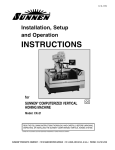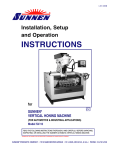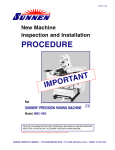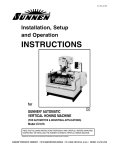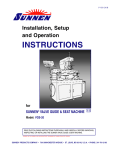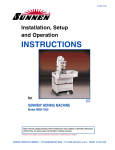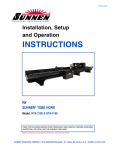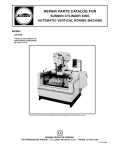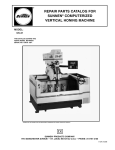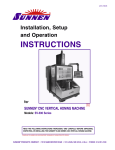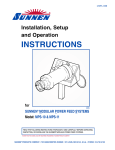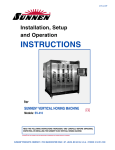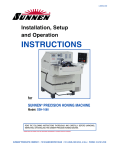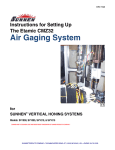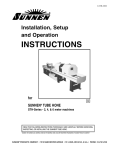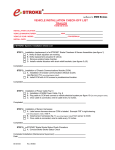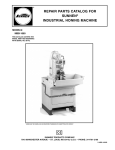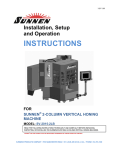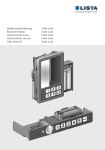Download INSTRUCTIONS
Transcript
I-CH-103C Installation, Setup and Operation INSTRUCTIONS for SUNNEN® HORIZONTAL HONE Model CH-100 READ THE FOLLOWING INSTRUCTIONS THOROUGHLY AND CAREFULLY BEFORE UNPACKING, INSPECTING, OR INSTALLING THE SUNNEN® HORIZONTAL HONE. “SUNNEN AND THE SUNNEN LOGO ARE REGISTERED TRADEMARKS OF SUNNEN PRODUCTS COMPANY.” SUNNEN ® PRODUCTS COMPANY • 7910 MANCHESTER ROAD • ST. LOUIS, MO 63143, U.S.A. • PHONE: 314-781-2100 GENERAL INFORMATION The Sunnen® equipment has been designed and engineered for a wide variety of parts within the capacity and limitation of the equipment. With proper care and maintenance this equipment will give years of service. READ THE FOLLOWING INSTRUCTIONS CAREFULLY AND THOROUGHLY BEFORE UNPACKING, INSPECTING, OR INSTALLING THIS EQUIPMENT. IMPORTANT: Read any supplemental instructions BEFORE installing this equipment. These supplemental instructions give you important information to assist you with the planning and installation of your Sunnen equipment. Sunnen Technical Service Department is available to provide telephone assistance for installation, programming, & troubleshooting of your Sunnen equipment. All support is available during normal business hours, 8:00 AM to 4:30 PM Central Time. Review all literature provided with your Sunnen equipment. This literature provides valuable information for proper installation, operation, and maintenance of your equipment. Troubleshooting information can also be found within the Instructions. If you cannot find what you need, call for technical support. Where applicable, programming information for your Sunnen equipment is also included. Most answers can be found in the literature packaged with your equipment. Help us help you. When ordering parts, requesting information, or technical assistance about your equipment, please have the following information available: • Have ALL MANUALS on hand. The Customer Services Representative or Technician will refer to it. • Have Model Number and Serial Number printed on your equipment Specification Nameplate. • Where Applicable: Have Drive model and all nameplate data. Motor type, brand, and all nameplate data. For Troubleshooting, additional information may be required: • Power distribution information (type - delta, wye, power factor correction; other major switching devices used, voltage fluctuations) • Installation Wiring (separation of power & control wire; wire type/class used, distance between drive and motor, grounding). • Use of any optional devices/equipment between the Drive & motor (output chokes, etc.). For fast service on your orders call: Sunnen Automotive Customer Service toll free at: 1-800-772-2878 Sunnen Industrial Customer Service toll free at: 1-800-325-3670 Customers outside the USA, contact your local authorized Sunnen Distributor. Additional information available at: http://www.sunnen.com or e-mail: [email protected] NOTE: Sunnen reserves the right to change or revise specifications and product design in connection with any feature of our products contained herein. Such changes do not entitle the buyer to corresponding changes, improvements, additions, or replacements for equipment, supplies or accessories previously sold. Information contained herein is considered to be accurate based on available information at the time of printing. Should any discrepancy of information arise, Sunnen recommends that user verify the discrepancy with Sunnen before proceeding. ESD PREVENTION REVIEW Let's review the basics of a sound static control system and its effective implementation. First, in the three step plan: 1. Always ground yourself when handling sensitive components or assemblies. 2. Always use a conductive or shielded container during storage or transportation. These materials create a Faraday cage which will isolate the contents from static charges. 3. Open ESD safe containers only at a static safe work station. At the static safe work station, follow these procedures before beginning any work: A. Put on your wrist strap or foot grounding devices. B. Check all grounding cords to make sure they are properly connected to ground, ensuring the effective dissipation of static charges. C. Make sure that your work surface is clean and clear of unnecessary materials, particularly common plastics. D. Anti-static bubble wrap has been included for use at the machine when an ESD safe workstation is not available. You are now properly grounded and ready to begin work. Following these few simple rules and using a little common sense will go a long way toward helping you and your company in the battle against the hazards of static electricity. When you are working with ESD sensitive devices, make sure you: GROUND ISOLATE NEUTRALIZE ii SUNNEN® LIMITED PRODUCT WARRANTY Sunnen® Products Company and its subsidiaries (SPC) warrant that all new SPC honing machines, gaging equipment, tooling, and related equipment will be free of defects in material and/or workmanship for a period of one year from the date of original shipment from SPC. Upon prompt notification of a defect during the one-year period, SPC will repair, replace, or refund the purchase price, with respect to parts that prove to be defective (as defined above). Any equipment or tooling which is found to be defective from improper use will be returned at the customer's cost or repaired (if possible) at customer's request. Customer shall be charged current rates for all such repair. Prior to returning any SPC product, an authorization (RMA#) and shipping instructions must be obtained from the Customer Service Department or items sent to SPC will be returned to the customer. Warranty Limitations and Exclusions This Warranty does not apply to the following: • Normal maintenance items subject to wear and tear: (belts, fuses, filters, etc). • Damages resulting from but not limited to: › Shipment to the customer (for items delivered to customer or customer's agent F.O.B., Shipping Point) › Incorrect installation including improper lifting, dropping and/or placement › Incorrect electric power (beyond +/- 10% of rated voltage) including intermittent or random voltage spikes or drops › Incorrect air supply volume and/or pressure and/or contaminated air supply › Electromagnetic or radio frequency interference from surrounding equipment (EMI, RFI) › Storm, lightning, flood or fire damage › Failure to perform regular maintenance as outlined in SPC manuals › Improper machine setup or operation causing a crash to occur › Misapplication of the equipment › Use of non-SPC machines, tooling, abrasive, fixturing, coolant, repair parts, or filtration › Incorrect software installation and/or misuse › Non-authorized customer installed electronics and/or software › Customer modifications to SPC software THE LIMITED WARRANTY DESCRIBED HEREIN IS EXPRESSLY IN LIEU OF ALL ANY OTHER WARRANTIES. SPC MAKES NO REPRESENTATION OR WARRANTY OF ANY OTHER KIND, EXPRESS OR IMPLIED, WHETHER AS TO MERCHANTABILITY, FITNESS FOR A PARTICULAR PURPOSE OR ANY OTHER MATTER. SPC IS NOT RESPONSIBLE FOR THE IMPROPER USE OF ANY OF ITS PRODUCTS. SPC SHALL NOT BE LIABLE FOR DIRECT, INDIRECT, INCIDENTAL, OR CONSEQUENTIAL DAMAGES INCLUDING BUT NOT LIMITED TO: LOSS OF USE, REVENUE, OR PROFIT. SPC ASSUMES NO LIABILITY FOR PURCHASED ITEMS PRODUCED BY OTHER MANUFACTURERS WHO EXTEND SEPARATE WARRANTIES. REGARDLESS OF ANY RIGHTS AFFORDED BY LAW TO BUYER, SPC's LIABILITY, IF ANY, FOR ANY AND ALL CLAIMS FOR LOSS OR DAMAGES WITH RESPECT TO THE PRODUCTS, AND BUYER'S SOLE AND EXCLUSIVE REMEDY THEREFORE, SHALL IN ALL EVENTS BE LIMITED IN AMOUNT TO THE PURCHASE PRICE OF THAT PORTION OF THE PRODUCTS WITH RESPECT TO WHICH A VALID CLAIM IS MADE. Shipping Damages Except in the case of F.O.B., Buyer's destination shipments, SPC will not be liable for any settlement claims for obvious and/or concealed shipping damages. The customer bears the responsibility to unpack all shipments immediately and inspect for damage. When obvious and/or concealed damage is found, the customer must immediately notify the carrier's agent to make an inspection and file a claim. The customer should retain the shipping container and packing material. SUNNEN® SOFTWARE LICENSE AGREEMENT This document is a Legal Agreement between you, as user and licensee (Licensee), and Sunnen® Products Company (SPC) with respect to preprogrammed software (Software) provided by SPC for use on SPC Equipment. By using the Software, you, as Licensee, agree to become bound by the terms of this Agreement. In consideration of payment of the license fee (License Fee) which is part of the price evidenced by your receipt (Receipt), SPC grants to you as Licensee a non-exclusive right, without right to sub-license, to use the particular copy of the SPC Software licensed hereunder only on the particular equipment sold with the Software. SPC reserves all rights including rights not otherwise expressly granted, and retain title and ownership to the Software including all subsequent copies or updates in any media. The Software and all accompanying written materials are covered by copyrights owned by SPC. If supplied on removable media (floppy disk), you, as Licensee, may copy the Software only for back up purposes; or you may request that SPC copy the Software for you for the same purposes. All other copying of the Software or of the accompanying written materials is expressly forbidden and is in violation of the Agreement. The Software and accompanying written materials (including the user's manual, if any) are provided in an "as is" condition without warranty of any kind including the implied warranties of merchantability and fitness for a particular purpose, even if SPC has been advised of this purpose. SPC specifically does not warrant that it will be liable as a result of the operation of the Software for any direct, indirect, consequential or accidental damages arising out of the use of or inability to use such product even if SPC has been advised of the possibility of such use. It is recognized that some states do not allow the exclusion or limitation of liability for consequential or accidental damages and to the extent this is true, the above limitations may not apply. Any alteration or reverse engineering of the software is expressly forbidden and is in violation of this agreement. SPC reserves the right to update the software covered by this agreement at any time without prior notice and any such updates are covered by this agreement. iii SAFETY INSTRUCTIONS READ FIRST This machine, like any equipment, may be dangerous if used improperly. Please read all warnings and instructions before attempting to use this machine. Always disconnect power at main enclosure before servicing machine.1 Always wear eye protection when operating this machine. NEVER open or remove any machine cover or protective guard with power "ON." Always disconnect power at main enclosure before servicing this equipment.1 DO NOT attempt any repair or maintenance procedure beyond those described in this book. Contact your Sunnen® Field Service Engineer or Technical Services Representative for repairs not covered in these instructions. Due to the wide variety of machine configurations, all possibilities cannot be described in these instructions. Instructions for safe use and maintenance of optional equipment ordered through Sunnen, will be provided through separate documentation and/or training provided by your Sunnen Field Service Engineer or Technical Services Representative. DO NOT attempt to defeat any safety device on this machine or on any of the optional equipment. If specially built automation components are added to this system, be sure that safety is not compromised. If necessary, obtain special enlarged work area safety system from Sunnen Products Co. Indicates CE version ONLY. 1 DO NOT touch electrical components until main input power has been turned off and CHARGE lamps are extinguished. WARNING: The capacitors are still charged and can be quite dangerous. TABLE OF CONTENTS Page TABLE OF CONTENTS . . . . . . . . . . . . . . . . . . . . . . . . . . . . . . . . . . . . . . . . . . . . . . . . . . . . . . . . . . . . . . . . v LIST OF APPENDIXES . . . . . . . . . . . . . . . . . . . . . . . . . . . . . . . . . . . . . . . . . . . . . . . . . . . . . . . . . . . . . . . . v GENERAL INFORMATION & SPECIFICATIONS . . . . . . . . . . . . . . . . . . . . . . . . . . . . . . . . . . . . . . . . . vi INTRODUCTION . . . . . . . . . . . . . . . . . . . . . . . . . . . . . . . . . . . . . . . . . . . . . . . . . . . . . . . . . . . . . . . . . . . . vii FLOOR LAYOUT (Configuration) . . . . . . . . . . . . . . . . . . . . . . . . . . . . . . . . . . . . . . . . . . . . . . . . . . . . . . viii INSTALLATION . . . . . . . . . . . . . . . . . . . . . . . . . . . . . . . . . . . . . . . . . . . . . . . . . . . . . . . . . . . . . . . . . . . . . . . 1 Purpose . . . . . . . . . . . . . . . . . . . . . . . . . . . . . . . . . . . . . . . . . . . . . . . . . . . . . . . . . . . . . . . . . . . . . . . . . . . . . .1 Tools & Materials . . . . . . . . . . . . . . . . . . . . . . . . . . . . . . . . . . . . . . . . . . . . . . . . . . . . . . . . . . . . . . . . . . . . . .1 Installation . . . . . . . . . . . . . . . . . . . . . . . . . . . . . . . . . . . . . . . . . . . . . . . . . . . . . . . . . . . . . . . . . . . . . . . . . . . .I Electrical Connection . . . . . . . . . . . . . . . . . . . . . . . . . . . . . . . . . . . . . . . . . . . . . . . . . . . . . . . . . . . . . . . . . . .3 Filter Element . . . . . . . . . . . . . . . . . . . . . . . . . . . . . . . . . . . . . . . . . . . . . . . . . . . . . . . . . . . . . . . . . . . . . . . . .3 Tool Support . . . . . . . . . . . . . . . . . . . . . . . . . . . . . . . . . . . . . . . . . . . . . . . . . . . . . . . . . . . . . . . . . . . . . . . . . .3 PREPARING FOR OPERATION . . . . . . . . . . . . . . . . . . . . . . . . . . . . . . . . . . . . . . . . . . . . . . . . . . . . . . . . . .5 General . . . . . . . . . . . . . . . . . . . . . . . . . . . . . . . . . . . . . . . . . . . . . . . . . . . . . . . . . . . . . . . . . . . . . . . . . . . . . .5 Theory of Operation . . . . . . . . . . . . . . . . . . . . . . . . . . . . . . . . . . . . . . . . . . . . . . . . . . . . . . . . . . . . . . . . . . . .5 Major Components . . . . . . . . . . . . . . . . . . . . . . . . . . . . . . . . . . . . . . . . . . . . . . . . . . . . . . . . . . . . . . . . . . . . .5 Controls . . . . . . . . . . . . . . . . . . . . . . . . . . . . . . . . . . . . . . . . . . . . . . . . . . . . . . . . . . . . . . . . . . . . . . . . . . . . . .5 Hone Unit . . . . . . . . . . . . . . . . . . . . . . . . . . . . . . . . . . . . . . . . . . . . . . . . . . . . . . . . . . . . . . . . . . . . . . . . . . . .7 OPERATION . . . . . . . . . . . . . . . . . . . . . . . . . . . . . . . . . . . . . . . . . . . . . . . . . . . . . . . . . . . . . . . . . . . . . . . . . .9 General . . . . . . . . . . . . . . . . . . . . . . . . . . . . . . . . . . . . . . . . . . . . . . . . . . . . . . . . . . . . . . . . . . . . . . . . . . . . . .9 Safety Precautions . . . . . . . . . . . . . . . . . . . . . . . . . . . . . . . . . . . . . . . . . . . . . . . . . . . . . . . . . . . . . . . . . . . . . .9 Honing Hints . . . . . . . . . . . . . . . . . . . . . . . . . . . . . . . . . . . . . . . . . . . . . . . . . . . . . . . . . . . . . . . . . . . . . . . . . .7 Setup . . . . . . . . . . . . . . . . . . . . . . . . . . . . . . . . . . . . . . . . . . . . . . . . . . . . . . . . . . . . . . . . . . . . . . . . . . . . . . . .9 Operation . . . . . . . . . . . . . . . . . . . . . . . . . . . . . . . . . . . . . . . . . . . . . . . . . . . . . . . . . . . . . . . . . . . . . . . . . . . . .9 ROUTINE MAINTENANCE . . . . . . . . . . . . . . . . . . . . . . . . . . . . . . . . . . . . . . . . . . . . . . . . . . . . . . . . . . . .15 General . . . . . . . . . . . . . . . . . . . . . . . . . . . . . . . . . . . . . . . . . . . . . . . . . . . . . . . . . . . . . . . . . . . . . . . . . . . . .15 Cleaning . . . . . . . . . . . . . . . . . . . . . . . . . . . . . . . . . . . . . . . . . . . . . . . . . . . . . . . . . . . . . . . . . . . . . . . . . . . .15 Lubrication . . . . . . . . . . . . . . . . . . . . . . . . . . . . . . . . . . . . . . . . . . . . . . . . . . . . . . . . . . . . . . . . . . . . . . . . . .15 Coolant Level . . . . . . . . . . . . . . . . . . . . . . . . . . . . . . . . . . . . . . . . . . . . . . . . . . . . . . . . . . . . . . . . . . . . . . . .16 Coolant Reservoir . . . . . . . . . . . . . . . . . . . . . . . . . . . . . . . . . . . . . . . . . . . . . . . . . . . . . . . . . . . . . . . . . . . . .16 Filter Canister . . . . . . . . . . . . . . . . . . . . . . . . . . . . . . . . . . . . . . . . . . . . . . . . . . . . . . . . . . . . . . . . . . . . . . . .16 Filter Element . . . . . . . . . . . . . . . . . . . . . . . . . . . . . . . . . . . . . . . . . . . . . . . . . . . . . . . . . . . . . . . . . . . . . . . .17 Hone Unit . . . . . . . . . . . . . . . . . . . . . . . . . . . . . . . . . . . . . . . . . . . . . . . . . . . . . . . . . . . . . . . . . . . . . . . . . . .19 Cradle Drive Chain . . . . . . . . . . . . . . . . . . . . . . . . . . . . . . . . . . . . . . . . . . . . . . . . . . . . . . . . . . . . . . . . . . . .19 TROUBLESHOOTING . . . . . . . . . . . . . . . . . . . . . . . . . . . . . . . . . . . . . . . . . . . . . . . . . . . . . . . . . . . . . . . . .21 General . . . . . . . . . . . . . . . . . . . . . . . . . . . . . . . . . . . . . . . . . . . . . . . . . . . . . . . . . . . . . . . . . . . . . . . . . . . . .21 Operational Troubleshooting Index . . . . . . . . . . . . . . . . . . . . . . . . . . . . . . . . . . . . . . . . . . . . . . . . . . . . . . . .21 APPENDIXES A Check List, Setup & Operation . . . . . . . . . . . . . . . . . . . . . . . . . . . . . . . . . . . . . . . . . . . . . . . . . . . . . . . . . 21 B Check List, Work Cycle Sequence . . . . . . . . . . . . . . . . . . . . . . . . . . . . . . . . . . . . . . . . . . . . . . . . . . . . . . . 23 “SUNNEN® IS A REGISTERED TRADEMARKS OF SUNNEN PRODUCTS COMPANY.” © Copyright 2006 by Sunnen® Products Company • Printed in U.S.A. v GENERAL INFORMATION & SPECIFICATIONS Sunnen Horizontal (Line) Hone - Model CH-100 Work Capacity*: V-blocks, both 60 & 90; angle head blocks; overhead & L-head in-line blocks; Up to 45 L x 28 W x 28 in. from head deck to main brg. centerline (1140 x 710 x 710 mm) Workpiece Weight*: Diameter Range(ID)*: (Main Bearing Bore) Stroke Length*: Motor: Coolant Capacity Minimum: Maximum: Coolant Requirements: 1.800 to 7.000 in. (46 - 178 mm) Note: Special tooling is required above 5 in. (127 mm) 26 in. (660 mm) Max. 1.5 HP (2,0 kW) 35 gal. (132 liters) 55 gal. (207 liters) Sunnen CK-50 Honing Oil Note: Use MAN-845 when honing aluminum Electrical Requirements: 115/230 V, 1 Ph, 60 Hz; 220 V, 1 Ph, 50 Hz (See Motor Plate) Shipping Weight: 1650 lbs. (750 kg) Floor Weight: 1450 lbs. (660 kg) Color: Pearl Gray / Pewter Gray / Burgundy Trim vi INTRODUCTION This Instruction Manual provides information required to install, operate, and maintain the Sunnen® CH-100 Horizontal Hone. When ordering parts for, or requesting information about your unit, include the serial numbers of both your kit and your machine. READ THE FOLLOWING INSTRUCTIONS THOROUGHLY BEFORE UNPACKING, INSPECTING, OR INSTALLING THE SUNNEN® CH-100 HORIZONTAL HONE. MAXIMUM OVERALL DIMENSIONS OF ENGINE BLOCKS FOR WHICH SUNNEN CH-100 HORIZONTAL (LINE) HONE IS DESIGNED. 28 in. (711 mm) MAIN BEARING CENTERLINE V-TYPE BLOCKS: 45 in. (1143) Long 28 in. (711) Wide 28 in. (711 mm) Top Surface to Main Bearing Centerline 28 in. (711 mm) IN-LINE BLOCKS: 45 in. (1143) Long 28 in. (711) Wide 28 in. (711 mm) Head Surface to Main Bearing Centerline HEAD SURFACE MAIN BEARING BORE Roundness Accuracy: .0005 in. (0,0125 mm) Alignment Accuracy: .0005 in. (0,0125 mm) 28 in. (711 mm) MAIN BEARING CENTERLINE TOP SURFACE 28 in. (711 mm) OPERATOR Scale: 1/4 in. = 1 ft. 1 mm = 48 mm OUTLINE LAYOUT viii FIGURE 1-A, Floor Plan - Sunnen® Tube Hone ADJUSTABLE MAX. TRAVEL 7 in. (178 mm) LOWEST CRADLE POSITION 30 in. (760 mm) APPROXIMATE TRAVEL 72 in. (1830 mm) SIDE VIEW 42.5 in. (1080 mm) MAX. TRAVEL 15 in. (380 mm) ADJUSTABLE Floor Loading: Less than 90 lbs/sf (440 kg/sm). Weight Installed: Approximately 170 lbs. (770 kg) including coolant. WORK AREA 98 in. (2490 mm) MAX. STROKE LENGTH 26 in. (660 mm) 138 in. (3500 mm) 45 in. (1140 mm) FRONT VIEW 53.875 in. (1368 mm) TOP VIEW DOOR OPENING 48 in. (1220 mm) MAX. BLOCK LENGTH 18.125 in. (460 mm) DRIP TRAY REMOVABLE 66 in. (1676 mm) 41.125 in. (1048 mm) 50 in. (1270 mm) MIN. DOOR OPENING 24 in. (610 mm) MAX. TRAVEL SECTION 1 INSTALLATION GENERAL NOTE: When ordering parts for, or requesting information about your Hone, include model and serial number printed on machine nameplate. Consult this section when unpacking, inspecting and installing Sunnen® CH-100 Horizontal Hone. Hereafter, referred to as the Hone (see Figure 1-1). 1. Remove bolts from around base of shipping carton. TOOLS & MATERIALS 2. Remove staples and lift off top of carton. The following list of suggested tools and materials are needed for unpacking and installing your Hone. Knife Wire Cutter/Stripper Hammer Screwdriver (Std. Nose) Crow Bar Slip-Joint Pliers Tin Snips Open End Wrenches Hew Wrenches Cleaning Solvent 3. Cut down side of carton and remove. CAUTION DO NOT remove Leveling Bolts. 4. Remove four (4) Bolts securing Hone to skid, using 1/2" Open End Wrench. INSTALLATION CAUTION Use care when lifting and moving Hone. Approximate weight of Hone is 1450 lbs (660 kg). Read the following instructions carefully and thoroughly before unpacking and inspecting your Hone. All references to right and left in these instructions are, unless otherwise noted, are as one looks at Hone or assembly being described (refer to Figure 1-1). 5. Lift Hone from skid, using a Forklift. Insert forks under rear of Hone as shown (see Figure 1-2). Forks MUST be long enough to support Hone on both sides (approximately 48 in/1220 mm). Forks should be position under Hone from rear as shown. 6. Move Hone to staging area. 7. Remove Crank Handle, which is strapped to Cradle Assembly (see Figure 1-3). 8. Place Handle in slot in top of Hone and engage Elevating Screw. 9. Loosen Cradle Lock Screw and raise Cradle by turning Handle clockwise. RIGHT 10. Remove components packaged in base of Hone. LEFT 11. Remove any remaining packing material. FRONT 12. Inspect Hone and components for dents, scratches, or damage resulting from improper handling by carrier. If damage is evident, immediately file a claim with carrier. FIGURE 1-1, Sunnen Horizontal Hone CRANK HANDLE CRADLE FIGURE 1-2, Shipping Crate FIGURE 1-3, Cradle Assembly 1 13. Unpack boxes packaged with your Hone and check all items against enclosed packing list. Notify Sunnen Products Company of any missing or damaged items. JAM NUT LEVELING BOLT CAUTION Use care when lifting and moving Hone. Approximate weight of Hone is 1450 lbs (750 kg). 14. Move Hone to desired. LEVELING BOLT NOTE: Hone should be located on a leveled concrete floor. Allow space around Hone to give operator room to service the Hone (refer to Figure 1-A). There should be an overhead track and chain fall located over the Hone to aid in block installation. If no overhead track is available, allow ample space for use of a portable hoist-stand for heavy lifting. PLATE FIGURE 1-4, Leveling Bolts 14. Level Hone by adjusting Leveling Bolts in Base (see Figure 1-4). Level Hone both left to right and front to back, using a machinist level. Tighten all Jam Nuts. DRIP TRAY 15. Attach Drip Tray by sliding over top channel on right side of Hone (see Figure 1-5). 16. After unpacking and installing your Hone, clean and lubricate (refer to Section 4). FIGURE 1-5, Drip Tray 17. Fill Coolant Reservoir with 35 to 55 gallons (132-207 liters) of Sunnen Coolant, by pouring directly into reservoir. ELECTRICAL CONTROL PANEL NOTE: It is recommended that you use only Sunnen full strength Sunnen CK-50 Honing Oil. ELECTRICAL REQUIREMENTS All wiring is to be performed by a competent, Licensed Electrician in accordance with all local, state, and federal codes and regulations; along with any special information provided on machine nameplate or electrical specification plate. FIGURE 1-6, Electrical Enclosure WARNING All wiring and electrical equipment service should be performed by authorized personnel ONLY. MASTER ON/OFF SWITCH CAUTION Note model electrical supply cord requirement printed on machine nameplate or electrical specification plate. Do not attempt to connect machine if supply voltage is not within following acceptable limits as noted on nameplate or electrical specification plate. If supply voltage is not within these limits MACHINE WILL BE DAMAGED. Verify supply voltage is same as voltage on Machine Nameplate or Electrical Specifications Plate. If supply voltage does not match voltage stated on Electrical Specification Plate but is within acceptable limits, electrical connection can proceed but Machine Conversion below will be necessary. POWER CORD GRN WHT for 115V/60Hz BLK (GND) PE TERMINAL DISCONNECT BLOCK for 220V/50Hz & 230/60Hz FIGURE 1-7, Electrical Connection 2 230V UNIT 115V UNIT Outlet for 230 volt unit should look like the following. Outlet for 115 volt unit should look like the following. ADAPTER GROUNDING SCREW PROPER OUTLET GROUNDING PIN GROUNDING PIN Electrical supply cord is equipped with a grounding type plug. Make sure unit is connected to an outlet having the same configuration as the plug. No adapter is available or should be used with this unit. If the unit MUST be reconnected for use on a different type of electrical circuit, the reconnection should be made by a qualified electrician. Electrical supply cord is equipped with a grounding pin. A temporary adapter, may be used to connect this plug to a 2-pole receptacle, if a properly grounded outlet is not available. Temporary adapter should ONLY be used until a properly grounded outlet can be installed by a qualified electrician. Green-colored rigid ear, lug, etc., extending from adapter MUST be connected to a permanent ground, such as a properly grounded outlet box. Unit wiring should comply with all local, state, and federal codes and ordinances. Unit wiring should comply with all local, state, and federal codes and ordinances. FIGURE 1-8, Electrical ELECTRICAL CONNECTION unlock doors to Electrical Control Enclosure using key supplied with machine. Door(s) to enclosure is equipped with Key-Lock Safety Latches. For models with Cords: The Hone is a 115/230V, 1Ph, 60Hz. or 220V, 1Ph, 50Hz. machine. Make electrical connections as follows (see Figures 1-6 & 1-8): WARNING Residual Voltage exists for 2-3 minutes after Master ON/OFF Switch is turned OFF. Before working inside Enclosure, wait for all fans to stop running to allow drives to discharge. NOTE: In some cases, Hone may be direct wired to power source. All wiring is to be performed by a qualified person and in accordance with all local, state, and federal codes and regulations. 1. Ensure that Oil Pump and Master Control Switches are in their OFF positions. 2. Turn Master ON/OFF Switch to OFF position and open Doors. (Doors WILL NOT open unless Master ON/OFF Switch is in OFF position.) 2. Connect Electrical Supply Cord, on side of Electrical Control Panel, to properly polarized and grounded receptacle (refer to Figure 1-8). WARNING You must use hole provided. Drilling any new holes in electrical enclosure may void machine warranty. 3. If not provided: Remove hole plug from entrance hole in enclosure and install an approved oil tight fitting. 4. Insert Electrical Supply Cord through Oil Tight Fitting and route to Electrical Disconnect Block. Allow for approximately 600 mm of cable from where it enters Enclosure; then cut off excess. 5. Strip 254 mm (10 in.) off cable's outer jacket. 6. Strip 6 mm (1/4 in.) of insulation off each wire. 7. If applicable: Connect Green Wire (GRN) to PE Terminal on Electrical Disconnect Block. 8. Connect White Wire as noted in figure (refer to Figure 1-7). 9. Connect other three wires to Disconnect Block as noted in figure (refer to Figure 1-7). 10. Route and secure Cord inside of Enclosure. 11. Tighten Oil Tight Fitting. For models without Cords: A pre-drilled hole with an Oil Tight Fitting has been provided in Electrical Enclosure for Electrical Supply Cord (not supplied). Connect Cord as follows (see Figures 1-7 & 1-8). NOTE: For Cord dimensions refer to General Information & Specification at front of this manual. CAUTION Doors are equipped with lockable Safety Door Latches. Doors should be closed and latched during operation to prevent accidental interruption of operation from doors being opened. Doors Latches should be Locked-Out and Tagged during servicing to prevent machine from being powered up. 1. If applicable: Loosen Safety Latches on door(s) to enclosure, using a screwdriver. Or, on CE models, 3 12. Close and secure/lock Door(s) to Enclosure. 13. Route and connect Electrical Supply Cord to power source. Plug Cord into a properly polarized grounding-type wall receptacle (refer to Figure 1-8). 14. Turn ON Master ON/OFF Switch. HEX NUT (2) LOCKWASHER (2) HONE SUPPORT INSTALL TOOL SUPPORT Attach optional Sunnen CH-600 Tool Support, using holes provided on left end of Hone and hardware provided (see Figure 1-9). 3/8” HEX HEAD CAPSCREW (2) FIGURE 1-9, Tool Support VALVE BODY ASSEMBLY SPRING CLIPS OIL SPOUT ASSEMBLY CRANK HANDLE HARDWOOD BLOCK DRIP TRAY STOP PLATES GAGE BRACKET OIL PUMP THREADED ROD OIL PUMP INDICATOR NUT CRADLE ASSEMBLY CLAMPING BAR CARRIAGE & TORQUE ASSEMBLY PAN RISER BLOCKS DRILL ASSEMBLY CLAMP PLATE FIGURE 2-1, Major Components COOLANT PUMP SWITCH START (COOLANT PUMP) START (COOLANT PUMP) STOP (COOLANT PUMP) COOLANT PUMP INDICATOR FIGURE 2-2, Controls 4 SECTION 2 PREPARING FOR OPERATION GENERAL Valve Body Assembly: Automatically shuts off coolant when coolant spout assembly is raised. Clamp Plate: Permits coolant spout assembly to be raised or lowered. Hardwood Blocks: Protects hone cabinet when removing hone unit. Toot Support, optional: Provides support when loading or unloading hone unit into or out of Hone. Hone Driver: Controls cutting pressure and stone feed-up. Drill Assembly: Supplies power to turn hone unit. Lock Arm: Locks drill assembly in home position; releases so drill assembly can be placed in stored position. Carriage & Torque Assembly: Supports drill assembly and provides stroking capability. Mandrel Wrench: Used to position wedge and lock hone unit in hone driver. Wrench Socket: Used to tighten or loosen clamping nut on cradle. Consult this section when preparing Machine for operation. MAJOR COMPONENTS For locations and function of major components on your Hone, see Figure 2-1. Stop Plates: Set to stroke position and limits stroke length. Drip Tray: Catches oil runoff on left side of Hone and returns it to Coolant Reservoir. Cradle Assembly: Adjusts to accommodate engine blocks of almost any size or configuration. Moves up or down to permit alignment of main bearing bores and drill assembly. Riser Blocks: Adjustable for holding engine block. Clamping Bar: Holds engine block down. Threaded Rod: Used with clamping bar to hold engine block down. Clamping Nut: Secures clamping bar. Gage Bracket: Holds optional Dial Bore Gage. Drip Pan: Catches oil runoff on right side of Hone. Crank Handle: Used to adjust height of cradle assembly. Coolant Spout Assembly: Directs coolant to workpiece. Spring Clips: Enables unneeded coolant outlets to be sealed off. CONTROLS For locations and function of controls on your Hone, see Figure 2-2 and Table 2-1. SAFETY SYMBOLS For a description of safety symbols used on this machine refer to Table 2-2. TABLE 2-2, Operator Controls (Buttons & Switches) SYMBOL DESCRIPTION FUNCTION START (COOLANT PUMP) Black Pushbutton Switch Turns power ON to Coolant Pump. STOP (COOLANT PUMP) Red Pushbutton Switch Turns power OFF to Coolant Pump. COOLANT PUMP INDICATOR Indicator Light (Green) (DRILL ASSEMBLY) Trigger Switch Turns power ON to Drill Motor when trigger is depressed. Shuts OFF power to Drill when trigger is released. (VALVE BODY ASSEMBLY) Flow Control Valve Automatically turns ON coolant flow when coolant spout assembly is lowered. Shuts OFF coolant when assembly is raised. Indicates when power is being supplied to Coolant Pump. 5 TABLE 2-2, Safety Symbols SYMBOL DESCRIPTION FUNCTION Warning Label Warns that an electrical hazard exists. Warning Label Warns that safety glasses should be worn at all times when operating this machine. Warning Strip Warns that a physical hazard exists, and that proper precautions should be taken. Label Designates this machine is “CE” compliance. Warning Label Warns not to hold workpiece in hand without a torque resisting fixture. SELECT HONE UNIT Generally, for every two inches of engine block length, one stone is required in Hone Unit. Select Hone Unit, stones and shoes according to Tables 2-3 and 2-4 or refer to Sunnen Engine Rebuilding Catalog. If you find that you must use a quantity of stones and shoes other than those shown in Tables, you will have to use blank spacers in place of stones and shoes because tension blocks can only be installed to accommodate quantity of stones and shoes shown in Tables. A spacer for stones consist of a stoneholder with abrasive stone removed. A spacer for shoes consist of worn or filed-down shoes. Whenever stones and shoes need to be replaced, change all stones and shoes at one time. There must always be a pair of shoes opposite each stone. Do not mix stones and shoes between sets. Once you use a set of stones and shoes in a Hone Unit, do not use in a different Hone Unit. IMPORTANT If you intend to use these stones again, mark them so they can be replaced in same order. HONE UNIT IMPORTANT If you intend to use these shoes again, mark them so they can be replaced in same order and store with stones. 3. Remove stones by pulling each one up and toward drive end of unit. 4. Install new stones. 5. Insert Tension Block into unit. 6. Lightly snug Set Screw. 7. Using a piece of wood, lightly tap Block to set stone. Then tighten Screw. NOTE: There should be no back or forward movement of stones. If there movement, loosen screw and repeat step 6. 8. Repeat steps 2 thru 7 for replacing shoes. Assemble Hone Unit as follows (see Figure 2-3): 1. Select Hone Unit, stones and shoes. 2. Loosen Screw and remove Tension Block from slot on stone side of unit. TABLE 2-3, 10RY Series Hone Units Number of Stoneholders & Shoes BLOCK LENGTH 6 12 to 15 in (305 to 381 mm) 8 15 to 18 in (381 to 457 mm) 10 18 in (457 mm) or More 10RY TABLE 2-4, 15RY Series Hone Units Number of Stoneholders & Shoes 15RY BLOCK LENGTH 11 22 to 26 in (559 to 660 mm) 13 26 to 30 in (660 to 762 mm) 15 30 in (762 mm) or More FIGURE 2-3, Hone Unit 6 SECTION 3 SETUP & OPERATION GENERAL • If you ignore these three defects when rebuilding an engine, a hard turning or binding crankshaft is result. This binding robs engine of horsepower and quickly wears inserts ... or seizes and spins new inserts, which results in scored main bearing bore housings, and often a broken crankshaft. • In past correcting or even checking main bearing bores for alignment and size has been time consuming for even most highly skilled machinists. Often, main bearing bore misalignment is detected when crankshaft and new inserts are installed ... necessitating tearing down engine again, correcting problem, reassembling, and maybe replacing inserts because they were damaged during this assembly attempt. • An engine with a crankshaft, which barely turns, will have a short life at best. Good reputations and sales are not built this way. • With Sunnen CH Horizontal Hone Drive Unit, you can line hone main bearing bores of average passenger car block easily and quickly. This makes it practical to line hone every block without wasting your time checking to determine whether block needs to be corrected or not. In addition, you'll be sure that every block meets manufacturers' tolerances for alignment, roundness and size. • Line honing main bearing bores using revolutionary Sunnen method is relatively easy. It provides ultimate in accuracy for blue-print needs of high performance engine builders, yet offers speed required of jobber shops and volume rebuilders for lower operating costs. Sunnen Hone Units are available to cover diameter range from 1.8 to 5.0 in. (61-127 mm), giving every shop capability to line hone truck blocks as well as smallest passenger car blocks quickly, easily, and profitably. This section describes a step-by-step operating procedure for your Hone. SAFETY PRECAUTIONS The following precautions should be followed to ensure maximum safety of personnel while working on or around Hone. • Ensure area is clear of other personnel before operating Hone. • Keep loose tools and other foreign objects clear of Hone. • Wear proper Safety items such as, safety glasses and other personal safety equipment as necessary or required. • DO NOT wear loose fitting clothes or jewelry while working on or around Hone. • Keep area around Hone free of paper, oil, water and all other debris at all times. • Turn OFF electrical power when performing service not requiring power. • When lifting part or tooling use proper lifting procedures or equipment. THEORY OF OPERATION There are three primary reasons why main bearing bores require line honing. 1. When an engine is run for thousands of miles, stresses of heating and cooling of block cause block warpage and distortion; which causes misalignment of main bearing bore. Because warpage takes place over a long period, original main bearing inserts compensate for warpage through wear. However, when installing new inserts in warped block this misalignment, even though slight, is all that is needed to cause crankshaft to bind and quickly wear out new inserts. HONING HINTS Prior to installing engine block in Hone, ensure that following steps have been completed, as required. True Stones & Shoes: When using a hone unit with new stones and shoes, true in hone unit on a scrap block. Follow same the honing procedures as outlined in below, except use honing oil intermittently. Use just enough oil to keep stones from becoming clogged. Grind Caps: Note to volume rebuilders. Main bearing caps can be removed, ground, and reinstalled at another work station before putting block into Hone to keep from trying up Hone while caps are being ground. To schedule your production this way and grind caps before installing block in Hone, proceed as follows: 2. High loads generally cause main bearing caps to become larger in vertical direction (called stretch), and to pinch in at parting line. Again, as in reason 1, Original main bearing inserts compensate for cap stretch through excessive wear. Thus, installing new inserts in a block with stretched caps will cause crankshaft to bind and again prematurely wear out new inserts. 3. When excessive heat is generated, bearing may seize to crankshaft and spin with it, scoring main bearing bore housing. 7 • Remove all Bearing Caps. Mark caps and engine block to ensure caps are reinstalled in their original locations. Remove all burrs from main bearing web and cap parting surfaces with a fine file. Wipe surfaces clean. • Grind Bearing Caps on Sunnen CRG-750 Cap & Rod Grinder, CRG-2000 Cap Angle Grinder, or Sunnen CG-2400 Cap Grinder. RISER BLOCKS (RISERS CAN BE INVERTED TO FIT DIFFERENT SHAPED ENGINE BLOCKS) SETUP & OPERATION To hone main bearing bore, proceed as follows: 1. Turn OFF power to Hone. 2. Swing Oil Control Unit into position. Leave Oiler in up position. FIGURE 3-1, Position Riser Blocks 3. Raise Front Door Panels to clear latches and slide Door down into Hone. 4. Install V-type engine block in cradle. - Position Riser Blocks to accept V-type engine block (see Figure 3-1). Blocks may be positioned to accept either 60' or 90' engine block. NUT THREADED CLAMP ROD CAUTION To protect Cam Bearing Bores, Pad Bores with shop towels before inserting Clamp Bar. • Remove End Caps from Cam Bearing Bores and insert Clamp Bar into engine block. • Load engine block on Cradle; engage Threaded Clam p Rods with slots in Clamp Bar; then tighten Nuts (see Figure 3-2). FIGURE 3-2, V-Type Engine Block RISER BLOCKS 5. Install in-line engine block in cradle. • Place Riser Blocks so flat side is up to accept in-line engine block (see Figure 3-3). • Load engine block on Cradle by aligning Clamp Rods with center of two cylinders and lower block into position on Cradle. • Secure engine block by installing Clamping Straps and Nuts (see Figure 3-4). 6. If Bearing Caps have not previously been ground, proceed as follows: • Remove all Bearing Caps. Mark Caps and Engine Block to ensure caps are reinstalled in their original locations. • Remove all burrs from Main Bearing Web and Cap parting surfaces with a fine file. Wipe surfaces clean. • Grind Bearing Caps on Sunnen CRG-750 Cap and Rod Grinder or CG-2400 Cap Grinder. FIGURE 3-3, Position Riser Blocks THREADED CLAMP RODS JAM NUTS 7. Assemble Hone Unit. (Refer to section 2, or to instructions packaged with Unit.) CLAMPING STRAPS 8. Fully retract shoes on Hone Unit, by inserting Key in Slot in end of Unit and turning it counterclockwise (see Figure 3-5). Remove Key. FIGURE 3-4, In-Line Engine Block 8 9. Check centerline (see Figure 3-6) of main bearing bores, using a Depth Micrometer to check both block bearing bores and bearing caps. HONE UNIT IMPORTANT Some blocks have their main bearing bores machined off center; so that centerline of bores MUST be checked and hone unit centered in bores before bores can be resized. KEY • If block bearing bores are within .005 inch of half overall bore diameter go to step 10. • If block bearing bores are greater than or less than half overall bore diameter by more than .005 inch go to step 11. FIGURE 3-5, Retract Shoes WARNING Wear gloves or use shop towels when loading or unloading hone unit to prevent personal injury. CENTERED 10. Center hone unit using Centering Pins Method (see Figure 3-7): • Lay hone unit in main bearing bore, so stones are pointed up. • Insert Centering Pins (provided with hone unit) into Centering Holes in unit. • Position hone unit so Pins rest on Center Web (bore) in block, with an odd number of webs; or on either of Center Webs in engine blocks with an even number of webs. Hone unit can now be rocked lengthwise, pivoting on Centering Pins. • Insert key in slot in end of unit. • While rocking unit on Centering Pins, expand shoes by turning key clockwise until unit will not rock. • Remove key and Center Pins. • Remove hone unit from main bearing bores. • Reinstall and torque bearing caps on block. LOW CENTERLINE HIGH CENTERLINE FIGURE 3-6, Centerline CENTERING PINS WARNING Wear gloves or use shop towels when loading or unloading hone unit to prevent personal injury. 11. Center hone unit using Dial Indicator Method (see Figure 3-8): • Reinstall and torque bearing caps on engine block. • Using Tool Support, slide hone unit in main bearing bore, so stones are pointed up. • Mount Dial Indicator (not supplied) on engine block with Indicator Tip on end of hone unit . • Insert key in slot in end of hone unit. • While slowly rotating unit by hand, alternately expand stones and shoes until run-out is eliminated. Unit should run concentric to within .005 inch Total Indictor Reading (TIR). FIGURE 3-7, Centering Pin Method MAGNETIC BASE A B DIAL INDICATOR DIAL INDICATOR STONE FEED-UP KNOB HONE UNIT ENGINE BLOCK NOTE: Expand Shoes by turning Key clockwise and expand stones by turning Stone Feed-Up Knob clockwise. FIGURE 3-8, Dial Indicator Method 9 • Remove Key and Dial Indicator. • Slide Hone Unit from main bearing bores. 12. Measure diameters of main bearing bores. WARNING Wear gloves or use shop towels when loading or unloading hone unit to prevent personal injury. 13. Slide Hone Unit into main bearing bore, so stones are pointing up (see Figure 3-9): • Loosen Clamp Handle and roughly align Tool Support with main bearing bore. Retighten Handle. • Lay front end of hone unit on Roller, so shoes rest on roller. • Lift drive end of hone unit and slide on roller into main bearing bore. • Loosen Clamp Handle and lower roller, until it rest on Clamp Bracket. FIGURE 3-9, Insert Hone Unit CRANK HANDLE WARNING DO NOT operate Horizontal Hone with Tool Support Roller still in contact with Hone Unit. 14. Adjust height of Cradle, for type and size of block to be honed (see Figure 3-10): • Loosen Cradle Clamp. • Adjust Cradle height, using Crank Handle. Turn handle clockwise to raise cradle and counterclockwise to lower cradle. CRADLE LOCK SCREW FIGURE 3-10, Cradle Height NOTE: Centerline of main bearing bore should be in approximate alignment with centerline of Quick Coupler as illustrated. PINS HONE DRIVER • Tighten Cradle Clamp. QUICK RELEASE LEVER 15. Connect Hone Driver to Quick Coupler (see Figure 3-11). Align Cross Pins on Driver with Slot in Coupler; push Driver in Slot and turn clockwise to lock in place. 16. Set Overstroke as follows (see Figure 3-12): • Loosen Stroke Stops. QUICK COUPLER NOTE: On blocks with three Main Bearing Webs, position Hone Unit as shown. Stones should always remain in contact with webs. PINS HONE DRIVER FIGURE 3-11, Quick-Coupler STROKE LENGTH • On blocks with four or more Main Bearing Webs, position Hone Unit as shown. Hone Unit should be stroked past end webs as shown. • Move Overarm to left to set overstroke at left end of stroke. Move Left Stroke Stop against Drag Control and tighten securely. • Move Overarm to right to set overstroke at right end of stroke. Move Right Stroke Stop against Drag Control and tighten securely. OVERSTROKE (SET EQUAL OVERSTROKE ON OTHER END) END OF STROKE, DON’T STROKE ANY FURTHER TOWARD YOU OVERSTROKE (SET EQUAL OVERSTROKE ON OTHER END) STONE MAY LEAVE END OF WEB 17. Adjust Cutting Pressure, so stones will automatically advance during honing operation, as follows (see Figure 3-13): FIGURE 3-12, Overstroke 10 20. Push machine's START Lever to turn on oil. CHUCK WRENCH STONE FEED-UP KNOB ZERO “0” 21. Lower Oil Control into operating position, which will automatically turns oil flow on, and adjust Spring Clips to provide an even flow of oil to Main Bearing Web. To adjust volume of oil flow, use Oil Flow Valve on Hone's Oil Nozzle. WITNESS MARK 22. Stand behind Drive Motor, gripping Carriage and Motor Handle. Depress button on Handle to turn Drive Motor ON; then manually stroke bore with a even back and forth motion to pre-set stroke stops. CUTTING PRESSURE CONTROL DIAL FIGURE 3-13, Cutting Pressure NOTE: If bearing bores are on minimum size and caps are not ground, hone for 10 to 20 seconds. If caps are ground about .002 in. (0,05 mm), hone approximately 40 seconds. 23. Release button on Handle to STOP honing. 24. Turn Oil Flow OFF by pulling machine Lever forward part way. 90° PROPER ADJUSTMENT QUICK RELEASE LEVER 25. Disconnect Honing Unit at Quick Coupler, lift Quick Release Lever. 26. Slide Unit from bore: • Raise Tool Support until Roller contacts Shoes on Hone Unit. Then tighten Clamp Handle. (Rotate Hone Unit as required so shoes rest on Roller.) • Slide Hone Unit out of Main Bear Bore and rest drive end of Hone Unit on Carriage (see Figure 3-15). This allows hone unit to be removed without disturbing Stone Feed-Up Knob setting. FIGURE 3-14, Quick-Release Lever 27. Measure bores using Sunnen Dial Bore Gage. 28. Continue honing operation as required, until all bores are to size. When all bores are to size: 29. Gage each bearing bore: - If any bores are undersize, insert hone unit and hone to size. - If any bores are oversize, remove oversize caps, regrind, then reinstall caps and hone for two or three strokes. FIGURE 3-15, Remove Unit • Rotate Cutting Pressure Control Dial clockwise with Chuck Wrench (supplied) until "0" lines up with Witness Mark. • Turn Stone Feed-Up Knob clockwise as far as possible by hand. Then back off two (2) turns counterclockwise. 30. When all main bearing bores are to size: • Turn OFF machine. • Raise Oil Control Bar. • Disconnect Honing Unit at Quick Coupler, lift Quick Release Lever and remove Unit from bore. • Raise Front Door to clear latches and allow Doors to slide down into Hone. • Remove block from Hone and clean thoroughly. 18. Check Quick-Release Lever for proper adjustment as illustrated (see Figure 3-14). Readjust Stone Feed-Up Knob as required. 19. Raise Front Doors and latch into place. 11 TABLE 4-1, Lubrication ITEM LUBRICANT / PROCEDURE DESCRIPTION INTERVALS 1 CARRIAGE SHAFT LIGHT OIL: WIPE ON WEEKLY 2 IDLER ARM (2) LIGHT OIL: BRUSH ON MONTHLY 3 DRIVE CHAIN LIGHT OIL: BRUSH ON MONTHLY 4 ELEVATING SCREWS (2) #2 GREASE: BRUSH ON MONTHLY 5 CARRIAGE BEARING #1 GREASE: REPACK YEARLY 1 4 1 4 FIGURE 4-1, Carriage Shaft 2 4 OIL IDLER ARM (ONE IN EACH REAR CORNER) FIGURE 4-4, Elevating Screw CARRIAGE DRIVE SHAFT CARRIAGE LOCKING BEARING COLLAR FIGURE 4-2, Idler Arm LOCKING COLLAR STROKE STOP LOCKING SCREW STROKE STOP CARRIAGE 3 5 3 FIGURE 4-3, Drive Chain FIGURE 4-5,Carriage Bearing 12 SECTION 4 ROUTINE MAINTENANCE GENERAL Wash dirt from Cradle Elevating Screws, located on both sides of the machine, by brushing with clean honing oil; then lubricate with a SAE-30 viscosity machine oil (see Figure 3-4). The following procedures and suggested maintenance periods are given as guides only and are not to be construed as absolute or invariable. Local conditions must always be considered. Each machine must be maintained individually according to its particular requirements. Yearly - Repack Carriage Bearing with Mobilplex EP #1 grease or its equivalent as follows (see Figure 4-5): • Loosen Locking Screws in both Stroke Stops. • Remove Dog Point Screws from Locking Collars. Pull Carriage Drive Shaft partially out of Hone. • Remove Far Stroke Stop. • Pull Shaft approximately halfway through Carriage. • Repack Carriage Bearing with Mobilplex EP #1 grease or its equivalent. • Reassemble in reverse order. WARNING Turn OFF electrical power when performing service on your machine, which does not require power. Disconnect Machine from main power supply before any work is performed inside of Electrical Enclosure. CLEANING Clean exterior of Hone with warm water and a mild detergent or mild industrial solvent. Rinse thoroughly with clean hot water and wipe dry. COOLANT LEVER Hand lubricate various Hone components as follows (see Table 4-1): Monthly check level of Coolant in Coolant Reservoir and add Coolant as required by pouring coolant into reservoir. Replace Coolant using ONLY Sunnen CK-50 Industrial Honing Oil. NOTE: Intervals between lubrication will vary with amount of use your Hone receives. Lubricate all components at least once every six months. COOLANT RESERVOIR Weekly - Wipe the Carriage Shaft with a SAE-30 viscosity machine oil (see Figure 4-1). 1. Disconnect Coolant Supply Hose from Coolant Spout Assembly. Monthly: Oil the Idler Arms, located in the top rear comers of the machine, with a SEA-30 viscosity machine oil (see Figure 4-2). Brush Cradle Drive Chains, located on the sides and rear of the machine, with a SAE-30 viscosity machine oil (see Figure 4-3). 2. Direct Hose into waste container. LUBRICATION Periodically clean reservoir as follows (see Figure 4-6): 3. Lower Coolant Spout Assembly, which automatically turns coolant flow on. 4. Turn ON Coolant Switch and pump coolant into waste container. 5. As coolant level drops below pump intake, turn OFF Coolant Switch. 6. Remove Non-Splash Screens and siphon or dip out remaining coolant. 7. Remove Slug from reservoir. NON-SPLASH SCREEN 8. Wipe reservoir clean. 9. Fill the reservoir by pouring with 35 to 55 gallons (132-207 liters) of Sunnen CK-50 Honing Oil directly into the reservoir. COOLANT RESERVOIR 10. Reconnect Coolant Supply Hose to Coolant Spout Assembly. FIGURE 4-6, Honing Oil Reservoir 13 HONE UNIT To clean Hone Unit proceed as follows: 11. Reinstall Coupling and Stone Wedge Block and tighten Screw. 1. Loosen Screw and remove stone Tension Block from slot on stone side of unit (see Figure 4-7). 12. Reinstall Wedge, Retainer Block and stones in stone side of unit. 13. Reinstall stone Tension Block. IMPORTANT If you intend to use these stones again, mark them so they can be replaced in the same order. 14. Using a piece of wood, lightly tap Block to set stone (see Figure 4-13). Then tighten Screw. 15. Check stone for movement. There should be no back or forward movement of stones. If there is movement, loosen screw and repeat step 14. 2. Remove stones by pulling each one up and toward drive end of unit. 3. Remove stone Retainer Block, located on end of hone opposite Tension Block (see Figure 4-8). 16. Reinstall Wedges, Retainer Blocks and shoes in shoe side of unit. 4. Remove stone Wedge by pushing it away from Wedge Retainers and lifting out of slot (see Figure 4-9). 17. Reinstall shoe Tension Blocks. 18. Using a piece of wood, lightly tap Blocks to set shoes. Then tighten Screw. 5. Loosen Screw and remove Stone Wedge Block and Coupling from unit (see Figure 4-10). 19. Check shoes for movement. There should be no back or forward movement of shoes. If there is movement, loosen screw and repeat step 18. 6. Loosen Screw and remove shoe Tension Blocks from slot on shoe side of unit (see Figure 4-11). CRADLE DRIVE CHAIN IMPORTANT If you intend to use these shoes again, mark them so they can be replaced in the same order. Monthly inspect Cradle Drive Chain for proper chain tension and for signs of wear or damage. Replace or repair damage parts as required. Adjust Chain Tension as follows (see Figure 4-14): 7. Remove shoes by pulling each one up and toward drive end of unit. 1. Loosen Locking Nuts on Cam Sprockets, using 15/16" wrench. 8. Remove shoe Retainer Blocks, located on end of hone opposite Tension Block (see Figure 4-12). 2. Adjust Cam Sprockets as required by turning Cam Sprocket Studs, using 1/2" wrench. Deflection at center of chain should not be more than 5/8 in. (16 mm) as shown. 9. Remove shoe Wedges by pushing it away from Wedge Retainers and lifting out of slot. 10. Clean hone unit and component with warm water and a mild detergent or mild industrial solvent. Rinse thoroughly with clean hot water and wipe dry. 3. Retighten Locking Nuts. 14 TENSION BLOCK SCREW TENSION BLOCK SCREW FIGURE 4-7, Tension BLock FIGURE 4-11, Shoe Tension BLock RETAINER BLOCK RETAINER BLOCK FIGURE 4-8, Retainer Block FIGURE 4-12, Shoe Retainer Blocks (PUSH AWAY) TENSION BLOCK WEDGE RETAINER WEDGE (LIFT OUT) FIGURE 4-9, Wedge FIGURE 4-13, Set Stoneholders STONE WEDGE BLOCK NUT BOLT COUPLING FIGURE 4-10, Wedge Block & Coupling ADJUSTING CAM IDLER ARM ADJUSTING SCREW FIGURE 4-14, Cradle Drive Chain 15 NOTES 16 SECTION 5 TROUBLESHOOTING GENERAL OPERATIONAL TROUBLESHOOTING This section contains Troubleshooting information in table form, which should be used when problems occur with machine. Table lists problems encountered, possible causes, and solutions for problems along with reference to section of manual where detailed instructions may be found to correct problems. For suggestions on correcting problems with bore conditions or with honing operation; consult Table 5-1. TABLE 5-1, Operational Troubleshooting Index PROBLEM PROBABLE CAUSE SOLUTIONS 1. Stone Glazing (Stone looks clean). Stone not cutting 2. Stone Loading (Metal particles on stone surface). Hone unit whips when honing short blocks w/large dia. bores 1. Improper stone length. A. Check that Cutting Pressure on Hone Driver is set properly. B. Dress stones. C. Use softer stones. D. Check for bent Wedge. E. Check coolant*. F. Clean Hone Unit. A. Check that Cutting Pressure on Hone Driver is set properly. B. Use coarser stones. C. Check coolant*. SEC. 3 2 2 4 3 A. Remove one stoneholder & one pair of shoes from unit. B. If whipping persists, continue to remove stones and shoes until problem is eliminated. *NOTE: Many honing problems, such as poor tool life and rough finish, are caused by the wrong coolant, insufficient coolant, dirty coolant, or contaminated coolant. Use ONLY clean, full-strength Sunnen Industrial Honing Oils or WaterBased Coolants. DO NOT dilute or "cut"the oil or coolant in your Hone with other oil or coolants. Keep solvents and cleaning fluids away from your Hone. Sunnen CK-50 Honing Oil is recommended for most application; consult your local Sunnen Field Service Engine for coolant to use in your particular application. 17 NOTES 18 APPENDIX A CHECKLIST SETUP & OPERATION SEQUENCE SELECT HONE UNIT (Section 2) 1. Select stones and shoes; and assemble Hone Unit. SETUP & OPERATION (Section 3) 2. Turn OFF power to Hone. 3. Swing Oil Control Unit into position. Leave Oiler in up position. 4. Raise Front Door Panels to clear latches and slide Door down into Hone. 5. Position Riser Blocks to accept engine block. 6. Install in-line engine block in cradle. 7. Fully retract shoes on Hone Unit. 9. Check centerline of main bearing bores: • If block bearing bores are within .005 inch of half overall bore diameter go to step 10. • If block bearing bores are greater than or less than half overall bore diameter by more than .005 inch go to step 11. 10. Center hone unit using Centering Pins Method. 23. Release Trigger to STOP honing. 11. Center hone unit using Dial Indicator Method. 12. Measure diameters of main bearing bores. 13. Slide Hone Unit into main bearing bore, so stones are pointing up. 14. Adjust height of Cradle, for type and size of block to be honed. 15. Connect Hone Driver to Quick Coupler. 16. Set Overstroke. 17. Adjust Cutting Pressure, so stones will automatically advance during honing operation. 18. Check Quick-Release Lever for proper adjustment. 19. Raise Front Doors and latch into place. 20. Push machine's START Lever to turn on oil. 21. Lower Oil Control into operating position and adjust Spring Clips. 22. Stand behind Drive Motor, gripping Carriage and Motor Handle. Depress Trigger; then manually stroke bore with a even back and forth motion to pre-set stroke stops. 24. Turn Oil Flow OFF. 25. Disconnect Honing Unit. 26. Slide Unit from bore: 27. Measure bores. 28. Continue honing operation as required. 29. Gage each bearing bore: - If any bores are undersize, insert hone unit and hone to size. If any bores are oversize, remove oversize caps, regrind, then reinstall caps and hone for two or three strokes. 30. When all main bearing bores are to size: • Turn OFF machine. • Raise Oil Control Bar. • Disconnect Honing Unit at Quick Coupler. • Open Front Door. • Remove block from Hone and clean thoroughly. 19 NOTES 20 NOTES 21 NOTES 22 Like any machinery, this equipment may be dangerous if used improperly. Be sure to read and follow instructions for operation of equipment. FRACTION / DECIMAL / MILLIMETER EQUIVALENTS CHART INCH FRACTION DECIMAL MILLIMETER INCH FRACTION DECIMAL MILLIMETER INCH FRACTION DECIMAL MILLIMETER .... .003937 0,1000 9/32 .281250 7,1438 21/32 .656250 16,6688 .... .007874 0,2000 19/64 .296875 7,5406 .... .669291 17,0000 .... .011811 0,3000 5/16 .312500 7,9375 43/64 .671875 17,0656 1/64 .015625 0,3969 .... .314961 8,0000 11/16 .687500 17,4625 .... .015748 0,4000 21/64 .328125 8,3344 45/64 .703125 17,8594 .... .019685 0,5000 11/32 .343750 8,7313 .... .708661 18,0000 .... .023622 0,6000 .... .354331 9,0000 23/32 .718750 18,2563 .... .027559 0,7000 23/64 .359375 9,1281 47/64 .734375 18,6531 1/32 .031250 0,7938 3/8 .375000 9,5250 .... .748031 19,0000 .... .031496 0,8000 25/64 .390625 9,9219 3/4 .750000 19,0500 .... .035433 0,9000 .... .393701 10,0000 49/64 .765625 19,4469 .... .039370 1,0000 13/32 .406250 10,3188 25/32 .781250 19,8438 3/64 .046875 1,1906 27/64 .421875 10,7156 .... .787402 20,0000 1/16 .062500 1,5875 .... .433071 11,0000 51/64 .796875 20,2406 5/64 .078125 1,9844 7/16 .437500 11,1125 13/16 .812500 20,6375 .... .078740 2,0000 29/64 .453125 11,5094 .... .826772 21,0000 3/32 .093750 2,3813 15/32 .468750 11,9063 53/64 .828125 21,0344 7/64 .109375 2,7781 .... .472441 12,0000 27/32 .843750 21,4313 .... .118110 3,0000 31/64 .484375 12,3031 55/64 .859375 21,8281 1/8 .125000 3,1750 1/2 .500000 12,7000 .... .866142 22,0000 9/64 .140625 3,5719 .... .511811 13,0000 7/8 .875000 22,2250 5/32 .156250 3,9688 33/64 .515625 13,0969 57/64 .890625 22,6219 .... .157480 4,0000 17/32 .531250 13,4938 .... .905512 23,0000 11/64 .171875 4,3656 35/64 .546875 13,8906 29/32 .906250 23,0188 3/16 .187500 4,7625 .... .551181 14,0000 59/64 .921875 23,4156 .... .196850 5,0000 9/16 .562500 14,2875 15/16 .937500 23,8125 13/64 .203125 5,1594 37/64 .578125 14,6844 .... .944882 24,0000 7/32 .218750 5,5563 .... .590551 15,0000 61/64 .953125 24,2094 15/64 .234375 5,9531 19/32 .593750 15,0813 31/32 .968750 24,6063 .... .236220 6,0000 39/64 .609375 15,4781 .... .984252 25,0000 1/4 .250000 6,3500 5/8 .625000 15,8750 63/64 .984375 25,0031 17/64 .265625 6,7469 .... .629921 16,0000 1 1.000000 25,4000 .... .275591 7,0000 41/64 .640625 16,2719 1-1/16 1.062500 26,9880 FORMULAS: MULTIPLY INCHES (in) FEET (ft) x x BY 25.4 0.3048 = = TO GET MILLIMETERS (mm) METERS (m) MULTIPLY MILLIMETERS (mm) METERS (m) x x BY 0.03937 3.281 = = TO GET INCHES (in) FEET (ft) “SUNNEN AND THE SUNNEN LOGO ARE REGISTERED TRADEMARKS OF SUNNEN PRODUCTS COMPANY.” Sunnen® reserves the right to change or revise specifications and product design in connection with any feature of our products contained herein. Such changes do not entitle the buyer to corresponding changes, improvements, additions, or replacements for equipment, supplies or accessories previously sold. Information contained herein is considered to be accurate based on available information at the time of printing. Should any discrepancy of information arise, Sunnen recommends that user verify discrepancy with Sunnen before proceeding. PRINTED IN U.S.A. 0610 SUNNEN PRODUCTS LIMITED No. 1 Centro, Maxted Road Hemel Hempstead, Herts HP2 7EF ENGLAND Phone: ++ 44 1442 39 39 39 Fax: ++ 44 1442 39 12 12 www.sunnen.co.uk e-mail: [email protected] SUNNEN AG SUNNEN PRODUCTS COMPANY 7910 Manchester Road, St. Louis, MO 63143 U.S.A. Phone: 314-781-2100 Fax: 314-781-2268 U.S.A. Toll-Free Sales and Service – Automotive: 1-800-772-2878 • Industrial: 1-800-325-3670 International Division Fax: 314-781-6128 Fabrikstrasse 1 8586 Ennetaach-Erlen, Switzerland Phone: ++ 41 71 649 33 33 Fax: ++ 41 71 649 34 34 www.sunnen.ch e-mail: [email protected] SHANGHAI SUNNEN MECHANICAL CO., LTD. 889 Kang Qiao East Road, PuDong Shanghai 201319, P.R. China Phone: 86 21 5 813 3322 Fax: 86 21 5 813 2299 www.sunnensh.com e-mail: [email protected] SUNNEN ITALIA S.R.L. http://www.sunnen.com e-mail: [email protected] Viale Stelvio 12/15 20021 Ospiate di Bollate (MI) Italy Phone: 39 02 383 417 1 Fax: 39 02 383 417 50 www.sunnenitalia.com e-mail: [email protected] ©COPYRIGHT SUNNEN® PRODUCTS COMPANY 2006, ALL RIGHTS RESERVED

































